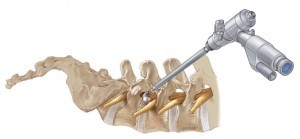Minimally Invasive Spine Surgery in Pune
What is minimally invasive spine surgery?
Spine surgery is traditionally done as “open surgery,” meaning the area being operated on is opened with a long incision to allow the surgeon to view and access the anatomy. In recent years, however, technological advances have allowed more back and neck conditions to be treated with a minimally invasive surgical technique.
Because minimally invasive spine surgery (MISS), does not involve a long incision, it avoids significant damage to the muscles surrounding the spine. In most cases, this results in less pain after surgery and a faster recovery.
What are benefits of minimally invasive spine surgery?
A New Era in Spinal Care provides a comprehensive overview of the philosophy of motion-sparing technology in the evolving arena of spinal arthroplasty. This book describes the type of patients being treated with these devices, the historical development of the implants, the techniques and technologies of spinal arthroplasty, clinical results, and a preview of the possibilities for the next generation of treatments. The contributing authors are experts in their respective areas of spinal arthroplasty, and, in some cases, they are the inventors of the devices.
• Minimal Hospital Stay
• Quick return to your routine
Which conditions can be treated with minimally invasive spine surgery?
Minimally invasive techniques are beginning to be used for a wider range of spine procedures, and have been used for common procedures like decompression and spinal fusion since the 1990s. Decompression relieves pressure put on spinal nerves by removing portions of bone or a herniated disk. Spinal fusion corrects problems with the small bones of the spine (vertebrae). The basic idea is to fuse together the painful vertebrae so that they heal into a single, solid bone. This article focuses on decompression and fusion with a minimally invasive technique.
- Degenerative disc disease: This disease usually develops in older adults. With increasing age disc gets more stiffen, loses flexibility, strength, height and shape, and the ability to absorb and distribute forces associated with movement. This can increase the risk of disc herniation. Minimally invasive surgery can be done to treat this condition.
- Herniated discs: A herniated disc occurs when the gel-like inner core of an intervertebral disc breaks through the protective outer layer of the disc. It can irritate and inflame nearby spinal nerves and cause back pain. This condition can be fixed by minimally invasive surgery.
- Scoliosis: It is the abnormal sideward curve of the spine that may cause progressive spinal deformity. It is mostly occurs in children, but adults can develop scoliosis, too. It can be treated with the help of minimally invasive surgery.
- Spinal stenosis: It occurs when the spinal cord becomes compressed. The nerve roots branch off the spinal cord and exit the spinal canal through passageways called neuroforamen. Nerve spinal cord compression can cause symptoms such as pain, weakness, tingling sensations, and numbness. Sometimes, pain and symptoms travel into the arms or legs.
How minimally invasive spine surgery is performed?
In minimally invasive spine surgery may involve percutaneous through the skin or small incision procedures. The surgery is performed through the tubular retraction system utilizing specially designed instruments. Types of surgical procedures performed minimally invasively include discectomy or microdiscectomy, foraminotomy or microforaminotomy, microlaminectomy and microlaminotomy.
Who can go for Minimally Invasive Spine Surgery?
Minimally invasive spine surgery is most advanced technique. It offers many benefits as compare to traditional surgery: smaller incisions, less pain, fewer risks, and quicker recovery times.
Minimally invasive spine surgery can be considered for patients for whom non-surgical treatments, such as medications, physical therapy, and/or spinal injections do not effectively reduce symptoms in 3 to 6 months. In addition, surgery is only considered if your doctor can pinpoint the exact source of your pain, such as a herniated disk or spinal stenosis.
Of course, certain types of spinal disorders need urgent or immediate surgical intervention. You should ask openly with your spine surgeon regarding your pain and symptoms. Before going for minimally invasive spine surgery, there are many considerations you and your doctor need to discuss before making a surgical decision to treat back or neck pain.
